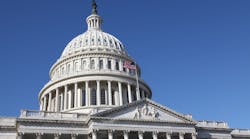Truckers took advantage of a wide-ranging Senate hearing Tuesday to push for sustainable, user-fee based highway funding, federal support of advanced truck safety systems, free trade, and tax relief—topics that found a sympathetic audience in the Republican-led Commerce subcommittee on surface transportation. Some members, however, did express safety and modal competitiveness concerns regarding a renewed call for twin 33-ft. trailers and the development of autonomous truck technology.
In his opening remarks for the hearing on multimodal freight policy, Werner Enterprises President & CEO Derek Leathers called for federal support for “a safe, uncongested, and reliable highway system,” with an investment focus on freight bottlenecks, as he emphasized the importance of trucking to the nation’s continued economic growth.
“The additional freight demand, combined with increased congestion, insufficient parking, and a patchwork of state regulations only add needless stress to our driver workforce and distract from the focus on safely and efficiently delivering our nation’s goods,” Leathers said.
While trucking supports “a variety of revenue sources to avoid over-reliance on a single option,” Leathers cautioned that higher user fees must be dedicated to programs that benefit freight movement on the highways. He said that increasing and indexing the federal fuel tax is the most efficient revenue source.
He also asked for help in solving a driver shortage for an industry that will need to hire 890,000 new drivers over the next decade.
“The industry and Congress need to collaborate to find workable solutions,” he said. His formal testimony offered specific recommendations:
- decrease significant CDL skills testing delays and wait times
- provide additional federal funds for driver training programs and removing barriers to students seeking federal aid to attend truck driving schools
- direct the Department of Labor to establish truck driving as a national in-demand occupation, which would free up resources devoted to filling vacant truck driving jobs
- implement the Entry-Level Driver Training rule; and
- require DOT to conduct a comprehensive study of efforts to streamline the licensing requirements between DOT and the Department of Defense.
He also credited the regulatory reforms included in the FAST Act—a push led by Subcommittee Chairman Deb Fischer (R.-NE)—for “improving coordination” between government and business.
FedEx Freight President and CEO Michael L. Ducker likewise emphasized the importance of funding an improved highway system, with sources to include an increased fuel tax, a vehicle-miles traveled (VMT) fee, and congestion pricing.
He also pointed to the importance of innovation, citing emerging technologies such as vehicle-to-vehicle and vehicle-to-infrastructure communications and autonomous vehicles, and said FedEx supports national uniformity in “reasonable and flexible guidelines.”
In terms of modernization, he called on Congress to review trucking equipment standards that haven’t been changed in more than 25 years. Specifically, FedEx “strongly supports” increasing twin trailer limits from 28 feet to 33 feet “with no, repeat, no change in the federal weight limit.”
“The highway networks are being overwhelmed with e-commerce,” Ducker said. “Twin-33 ft. trailers will make more efficient use of our existing infrastructure because it takes fewer trucks to haul the same amount of freight. Twin-33s are currently allowed in 20 states, and we have been operating them for many years without a single accident. They are safer than the current twin-28s. When widely adopted, twin-33s will improve safety, reduce congestion, reduce wear and tear on highways and bridges, increase productivity, save millions of gallons of fuel, and reduce billions of pounds of carbon emissions. That solution will result in near-instant infrastructure benefits with zero federal funding required. It’s a common sense policy solution.”
Railroads take exception
But Sen. Roger Wicker (R.-MS) noted that he’s “taken a strong position” against “forcing” twin-33s on the remaining 30 states, citing the “huge safety concerns” brought to him by various interest groups. And he asked Union Pacific Chairman, President and CEO Lance Fritz if the adoption of the longer standard would “tilt the playing field” and negatively impact the railroads.
“Our historic position has been one where we’ve not taken a position,” Fritz said, but he added that the rail industry is currently evaluating the issue.
Wicker then pointed out that “a number of entities” have reevaluated their positions on twin-33s, including the American Trucking Assns., which has backed away from its previous lobbying effort in support.
Modal competition also came up with regard to autonomous vehicle technology, as Fritz explained that the Federal Railroad Administration is developing a rule to require two people in the cab of a locomotive as the trucking representatives on the panel are calling for support of autonomous technology.
“It strikes me as extremely ironic that our federal safety regulator would mandate staying frozen in time for the railroads versus actively supporting our competitive mode in pursuing autonomous vehicles,” Fritz said. “Let technology take us where technology is going to take us.”
Asked specifically by Sen. Richard Blumenthal (D.-CT)—who expressed “severe apprehension” about the idea—for a timeline on driverless trucks, both the Werner and the FedEx representatives estimated that the time will be later rather than sooner.
“Obviously, the technology is evolving very rapidly. What we like about it is we get the safety benefits in the short term,” Leathers said. “But I think we are a long, long way away from true driverless trucks going down America’s roadways and hauling 80,000 pounds without a driver in the cab. Planes have been able to take off and land for a long time, but none of us got here today in a pilotless plane. These professional men and women [truck drivers] do many other tasks other than just driving. The anticipation and professionalism they bring to the job can’t be underestimated.”
Leathers went on to say that even estimates of 5-10 years for exit-to-exit self-driving trucks “may prove to be optimistic.”
Ducker agreed with Leathers on the need to embrace the technology, and noted that FedEx planes still have pilots. “Total autonomy is years and years away,” he said.
Union Pacific’s Fritz added that self-driving highway technology requires “well defined lanes and lots of communications infrastructure,” and that much of the highway system today is not up to the standards required by autonomous vehicles.
Asked by Sen. Maggie Hassen (D.-NH) if innovative technologies could help with the driver shortage, Leathers emphasized that the aim is not to replace drivers but to make the job more appealing.
“We’re not one that’s proposing that autonomous trucks are going to solve [the driver shortage] problem,” Leathers said. “I do believe that autonomous truck technology solves a different problem, which is it allows the driver to have a better way of life. If we can take the technologies that we’re gaining today—integrated collision mitigation, forward braking, forward cameras, lane departure—we can eliminate or greatly reduce accidents on our nation’s roadways. We want to see a focus on that type of investment, and for that type of investment to be better rewarded.”
He added that Werner had invested $980 million in safety technology over the last two years, “because to get the new technology, you need a new truck to go with it—and we’re buying those trucks in great volume to try to ensure a better lifestyle for our drivers.”




